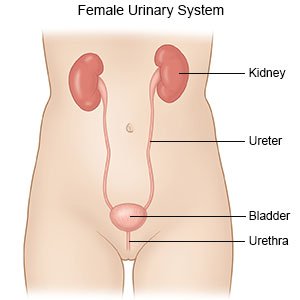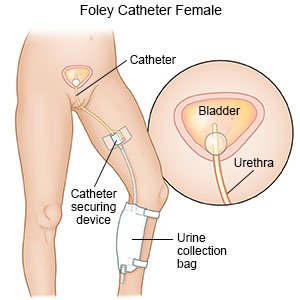Acute Urinary Retention in Women
Medically reviewed by Drugs.com. Last updated on Apr 6, 2025.
AMBULATORY CARE:
Acute urinary retention (AUR)
means your bladder is full, but you cannot urinate. This condition happens suddenly, gets worse quickly, and lasts a short time. AUR may be caused by weak bladder muscles, nerve damage, swelling, or an infection. A blockage such as a stone or growth and certain medicines can also cause AUR.
 |
Common signs and symptoms of AUR:
- Discomfort or pain in your lower abdomen
- A bloated lower abdomen
- An urge to urinate after you just went
- A urine stream that stops and starts on its own
Call your local emergency number (911 in the US) for any of the following:
- You are breathing faster than usual.
- Your heartbeat is faster than usual.
Seek care immediately if:
- You have severe abdominal pain.
- Your face, hands, feet, or ankles are swollen.
Drugs used to treat this and similar conditions
Urecholine
Urecholine is used for abdominal distension, urinary retention
Bloxiverz
Bloxiverz is used for reversal of neuromuscular blockade, urinary retention
Omvoh
Omvoh is used to treat moderate to severe ulcerative colitis or Crohn's disease in adults. This ...
Neostigmine
Neostigmine systemic is used for myasthenia gravis, reversal of neuromuscular blockade, reversal of ...
Bethanechol
Bethanechol systemic is used for abdominal distension, GERD, urinary retention
Call your doctor or gynecologist if:
- You have a fever.
- You have pain when you urinate.
- You see blood in your urine.
- You have problems with your catheter.
- You have questions or concerns about your condition or care.
Treatment
may include any of the following:
- A Foley catheter is a tube put into your bladder to drain urine into a bag. Keep the bag below your waist. This will prevent urine from flowing back into your bladder and causing an infection or other problems. Also, keep the tube free of kinks so the urine will drain properly. Do not pull on the catheter. This can cause pain and bleeding, and may cause the catheter to come out.

- Antibiotics help treat or prevent a bacterial infection.
Treatment options
The following list of medications are related to or used in the treatment of this condition.
Foley catheter care:
You may need a Foley catheter while you are at home. Healthcare providers will give you a smaller leg bag to collect urine. Keep the bag below your waist. This will prevent urine from flowing back into your bladder and causing an infection or other problems. Also, keep the tube free of kinks so the urine will drain properly. Do not pull on the catheter. This can cause pain and bleeding, and may cause the catheter to come out. Ask your healthcare provider for more information on Foley catheter care.
Follow up with your doctor or gynecologist as directed:
Write down your questions so you remember to ask them during your visits.
© Copyright Merative 2025 Information is for End User's use only and may not be sold, redistributed or otherwise used for commercial purposes.
The above information is an educational aid only. It is not intended as medical advice for individual conditions or treatments. Talk to your doctor, nurse or pharmacist before following any medical regimen to see if it is safe and effective for you.
Learn more about Acute Urinary Retention
Treatment options
Care guides
Further information
Always consult your healthcare provider to ensure the information displayed on this page applies to your personal circumstances.
